Efficiency Enhancement Strategies for Stable Bismuth-Based Perovskite and Its Bioimaging Applications
Abstract
1. Introduction
2. Results and Discussion
2.1. Optimization of BQDs and Structural Characterization
2.2. Optical Properties
3. Materials and Methods
3.1. Synthesis of Cs3Bi2Cl9 QDs and CeCl3-Doped Cs3Bi2Cl9 QDs
3.2. Structural Characterization
3.3. Optical Characterization
3.4. Cell Viability and Cellular Uptake
3.5. Cell Imaging
4. Conclusions
Supplementary Materials
Author Contributions
Funding
Institutional Review Board Statement
Informed Consent Statement
Data Availability Statement
Acknowledgments
Conflicts of Interest
References
- Kovalenko, M.V.; Protesescu, L.; Bodnarchuk, M.I. Properties and potential optoelectronic applications of lead halide perovskite nanocrystals. Science 2017, 358, 745–750. [Google Scholar] [CrossRef]
- Zhu, Y.; Liu, Y.; Miller, K.A.; Zhu, H.; Egap, E. Lead Halide Perovskite Nanocrystals as Photocatalysts for PET-RAFT Polymerization under Visible and Near-Infrared Irradiation. ACS Macro Lett. 2020, 9, 725–730. [Google Scholar] [CrossRef] [PubMed]
- Xu, Y.-F.; Yang, M.-Z.; Chen, B.-X.; Wang, X.-D.; Chen, H.-Y.; Kuang, D.-B.; Su, C.-Y. A CsPbBr3 Perovskite Quantum Dot/Graphene Oxide Composite for Photocatalytic CO2 Reduction. J. Am. Chem. Soc. 2017, 139, 5660–5663. [Google Scholar] [CrossRef] [PubMed]
- Zhu, Y.; Liu, Y.; Ai, Q.; Gao, G.; Yuan, L.; Fang, Q.; Tian, X.; Zhang, X.; Eilaf, E.; Ajayan, P.M.; et al. In Situ Synthesis of Lead-Free Halide Perovskite–COF Nanocomposites as Photocatalysts for Photoinduced Polymerization in Both Organic and Aqueous Phases. ACS Mater. Lett. 2022, 4, 464–471. [Google Scholar] [CrossRef]
- Gottesman, R.; Gouda, L.; Kalanoor, B.S.; Haltzi, E.; Tirosh, S.; Rosh-Hodesh, E.; Tischler, Y.; Zaban, A.; Quarti, C.; Mosconi, E. Photoinduced Reversible Structural Transformations in Free-Standing CH3NH3PbI3 Perovskite Films. J. Phys. Chem. Lett. 2015, 6, 2332–2338. [Google Scholar] [CrossRef]
- Hoke, E.T.; Slotcavage, D.J.; Dohner, E.R.; Bowring, A.R.; Karunadasa, H.I.; McGehee, M.D. Reversible photo-induced trap formation in mixed-halide hybrid perovskites for photovoltaics. Chem. Sci. 2015, 6, 613–617. [Google Scholar] [CrossRef]
- Mosconi, E.; Meggiolaro, D.; Snaith, H.J.; Stranks, S.D.; De Angelis, F. Light-induced annihilation of Frenkel defects in organo-lead halide perovskites. Energy Environ. Sci. 2016, 9, 3180–3187. [Google Scholar] [CrossRef]
- Nie, W.; Blancon, J.-C.; Neukirch, A.J.; Appavoo, K.; Tsai, H.; Chhowalla, M.; Alam, M.A.; Sfeir, M.Y.; Katan, C.; Even, J.; et al. Light-activated photocurrent degradation and self-healing in perovskite solar cells. Nat. Commun. 2016, 7, 11574. [Google Scholar] [CrossRef]
- Amgar, D.; Stern, A.; Rotem, D.; Porath, D.; Etgar, L. Tunable Length and Optical Properties of CsPbX(3) (X = Cl, Br, I) Nanowires with a Few Unit Cells. Nano. Lett. 2017, 17, 1007–1013. [Google Scholar] [CrossRef]
- Qiao, B.; Song, P.; Cao, J.; Zhao, S.; Shen, Z.; Di, G.; Liang, Z.; Xu, Z.; Song, D.; Xu, X. Water-resistant, monodispersed and stably luminescent CsPbBr(3)/CsPb(2)Br(5) core-shell-like structure lead halide perovskite nanocrystals. Nanotechnology 2017, 28, 445602. [Google Scholar] [CrossRef]
- Xuan, T.; Yang, X.; Lou, S.; Huang, J.; Liu, Y.; Yu, J.; Li, H.; Wong, K.-L.; Wang, C.; Wang, J. Highly stable CsPbBr3 quantum dots coated with alkyl phosphate for white light-emitting diodes. Nanoscale 2017, 9, 15286–15290. [Google Scholar] [CrossRef]
- Bryant, D.; Aristidou, N.; Pont, S.; Sanchez-Molina, I.; Chotchunangatchaval, T.; Wheeler, S.; Durrant, J.R.; Haque, S.A. Light and oxygen induced degradation limits the operational stability of methylammonium lead triiodide perovskite solar cells. Energy Environ. Sci. 2016, 9, 1655–1660. [Google Scholar] [CrossRef]
- Aristidou, N.; Eames, C.; Sanchez-Molina, I.; Bu, X.; Kosco, J.; Islam, M.S.; Haque, S.A. Fast oxygen diffusion and iodide defects mediate oxygen-induced degradation of perovskite solar cells. Nat. Commun. 2017, 8, 15218. [Google Scholar] [CrossRef] [PubMed]
- Ma, X.-X.; Li, Z.-S. The effect of oxygen molecule adsorption on lead iodide perovskite surface by first-principles calculation. Appl. Surf. Sci. 2018, 428, 140–147. [Google Scholar] [CrossRef]
- Zhang, D.; Eaton, S.W.; Yu, Y.; Dou, L.; Yang, P. Solution-Phase Synthesis of Cesium Lead Halide Perovskite Nanowires. J. Am. Chem. Soc. 2015, 137, 9230–9233. [Google Scholar] [CrossRef]
- Hoffman, J.B.; Schleper, A.L.; Kamat, P.V. Transformation of Sintered CsPbBr3 Nanocrystals to Cubic CsPbI3 and Gradient CsPbBrxI3-x through Halide Exchange. J. Am. Chem. Soc. 2016, 138, 8603–8611. [Google Scholar] [CrossRef]
- Lu, C.-H.; Biesold-McGee, G.V.; Liu, Y.; Kang, Z.; Lin, Z. Doping and ion substitution in colloidal metal halide perovskite nanocrystals. Chem. Soc. Rev. 2020, 49, 4953–5007. [Google Scholar] [CrossRef]
- Mir, W.J.; Sheikh, T.; Arfin, H.; Xia, Z.; Nag, A. Lanthanide doping in metal halide perovskite nanocrystals: Spectral shifting, quantum cutting and optoelectronic applications. NPG Asia Mater. 2020, 12, 9. [Google Scholar] [CrossRef]
- Chen, L.-J.; Lee, C.-R.; Chuang, Y.-J.; Wu, Z.-H.; Chen, C. Synthesis and Optical Properties of Lead-Free Cesium Tin Halide Perovskite Quantum Rods with High-Performance Solar Cell Application. J. Phys. Chem. Lett. 2016, 7, 5028–5035. [Google Scholar] [CrossRef]
- Hong, W.L.; Huang, Y.C.; Chang, C.Y.; Zhang, Z.C.; Tsai, H.R.; Chang, N.Y.; Chao, Y.C. Efficient Low-Temperature Solution-Processed Lead-Free Perovskite Infrared Light-Emitting Diodes. Adv. Mater. 2016, 28, 8029–8036. [Google Scholar] [CrossRef]
- Lai, M.L.; Tay, T.Y.; Sadhanala, A.; Dutton, S.E.; Li, G.; Friend, R.H.; Tan, Z.K. Tunable Near-Infrared Luminescence in Tin Halide Perovskite Devices. J. Phys. Chem. Lett. 2016, 7, 2653–2658. [Google Scholar] [CrossRef] [PubMed]
- Brandt, R.E.; Stevanović, V.; Ginley, D.S.; Buonassisi, T. Identifying defect-tolerant semiconductors with high minority-carrier lifetimes: Beyond hybrid lead halide perovskites. MRS Commun. 2015, 5, 265–275. [Google Scholar] [CrossRef]
- Ganose, A.M.; Savory, C.N.; Scanlon, D.O. Beyond methylammonium lead iodide: Prospects for the emergent field of ns2 containing solar absorbers. Chem. Commun. 2017, 53, 20–44. [Google Scholar] [CrossRef] [PubMed]
- Yang, Z.; Surrente, A.; Galkowski, K.; Bruyant, N.; Maude, D.K.; Haghighirad, A.A.; Snaith, H.J.; Plochocka, P.; Nicholas, R.J. Unraveling the Exciton Binding Energy and the Dielectric Constant in Single-Crystal Methylammonium Lead Triiodide Perovskite. J. Phys. Chem. Lett. 2017, 8, 1851–1855. [Google Scholar] [CrossRef]
- Leng, M.; Yang, Y.; Zeng, K.; Chen, Z.; Tan, Z.; Li, S.; Li, J.; Xu, B.; Li, D.; Hautzinger, M.P.; et al. All-Inorganic Bismuth-Based Perovskite Quantum Dots with Bright Blue Photoluminescence and Excellent Stability. Adv. Funct. Mater. 2018, 28, 1704446. [Google Scholar] [CrossRef]
- Wei, F.; Deng, Z.; Sun, S.; Zhang, F.; Evans, D.M.; Kieslich, G.; Tominaka, S.; Carpenter, M.A.; Zhang, J.; Bristowe, P.D.; et al. Synthesis and Properties of a Lead-Free Hybrid Double Perovskite: (CH3NH3)2AgBiBr6. Chem. Mater. 2017, 29, 1089–1094. [Google Scholar] [CrossRef]
- Ma, Z.-Z.; Shi, Z.-F.; Wang, L.-T.; Zhang, F.; Wu, D.; Yang, D.-W.; Chen, X.; Zhang, Y.; Shan, C.-X.; Li, X.-J. Water-induced fluorescence enhancement of lead-free cesium bismuth halide quantum dots by 130% for stable white light-emitting devices. Nanoscale 2020, 12, 3637–3645. [Google Scholar] [CrossRef]
- Saidaminov, M.I.; Mohammed, O.F.; Bakr, O.M. Low-Dimensional-Networked Metal Halide Perovskites: The Next Big Thing. ACS Energy Lett. 2017, 2, 889–896. [Google Scholar] [CrossRef]
- Ding, N.; Zhou, D.; Pan, G.; Xu, W.; Chen, X.; Li, D.; Zhang, X.; Zhu, J.; Ji, Y.; Song, H. Europium-Doped Lead-Free Cs3Bi2Br9 Perovskite Quantum Dots and Ultrasensitive Cu2+ Detection. ACS Sustain. Chem. Eng. 2019, 7, 8397–8404. [Google Scholar] [CrossRef]
- Yao, J.-S.; Ge, J.; Han, B.-N.; Wang, K.-H.; Yao, H.-B.; Yu, H.-L.; Li, J.-H.; Zhu, B.-S.; Song, J.-Z.; Chen, C.; et al. Ce3+-Doping to Modulate Photoluminescence Kinetics for Efficient CsPbBr3 Nanocrystals Based Light-Emitting Diodes. J. Am. Chem. Soc. 2018, 140, 3626–3634. [Google Scholar] [CrossRef]
- Morgan, E.E.; Mao, L.; Teicher, S.M.L.; Wu, G.; Seshadri, R. Tunable Perovskite-Derived Bismuth Halides: Cs3Bi2(Cl1−xIx)9. Inorg. Chem. 2020, 59, 3387–3393. [Google Scholar] [CrossRef] [PubMed]
- Zhang, Y.; Yin, J.; Parida, M.R.; Ahmed, G.H.; Jun, P.; Bakr, O.M.; Brédas, J.-L.; Mohammed, O.F. Direct-indirect nature of the bandgap in lead-free perovskite nanocrystals. J. Phys. Chem. Lett. 2017, 8, 3173–3177. [Google Scholar] [CrossRef] [PubMed]
- Kahmann, S.; Tekelenburg, E.K.; Duim, H.; Kamminga, M.E.; Loi, M.A. Extrinsic nature of the broad photoluminescence in lead iodide-based Ruddlesden–Popper perovskites. Nat. Commun. 2020, 11, 2344. [Google Scholar] [CrossRef]
- Zhu, J.; Xie, Z.; Sun, X.; Zhang, S.; Pan, G.; Zhu, Y.; Dong, B.; Xue, B.; Zhang, H.; Song, H. Highly efficient and stable inorganic perovskite quantum dots by embedding into a polymer matrix. ChemNanoMat 2019, 5, 346–351. [Google Scholar] [CrossRef]
- Datta, K.K.R.; Kozák, O.; Ranc, V.; Havrdová, M.; Bourlinos, A.B.; Šafářová, K.; Holá, K.; Tománková, K.; Zoppellaro, G.; Otyepka, M.; et al. Quaternized carbon dot-modified graphene oxide for selective cell labelling—Controlled nucleus and cytoplasm imaging. Chem. Commun. 2014, 50, 10782–10785. [Google Scholar] [CrossRef] [PubMed]
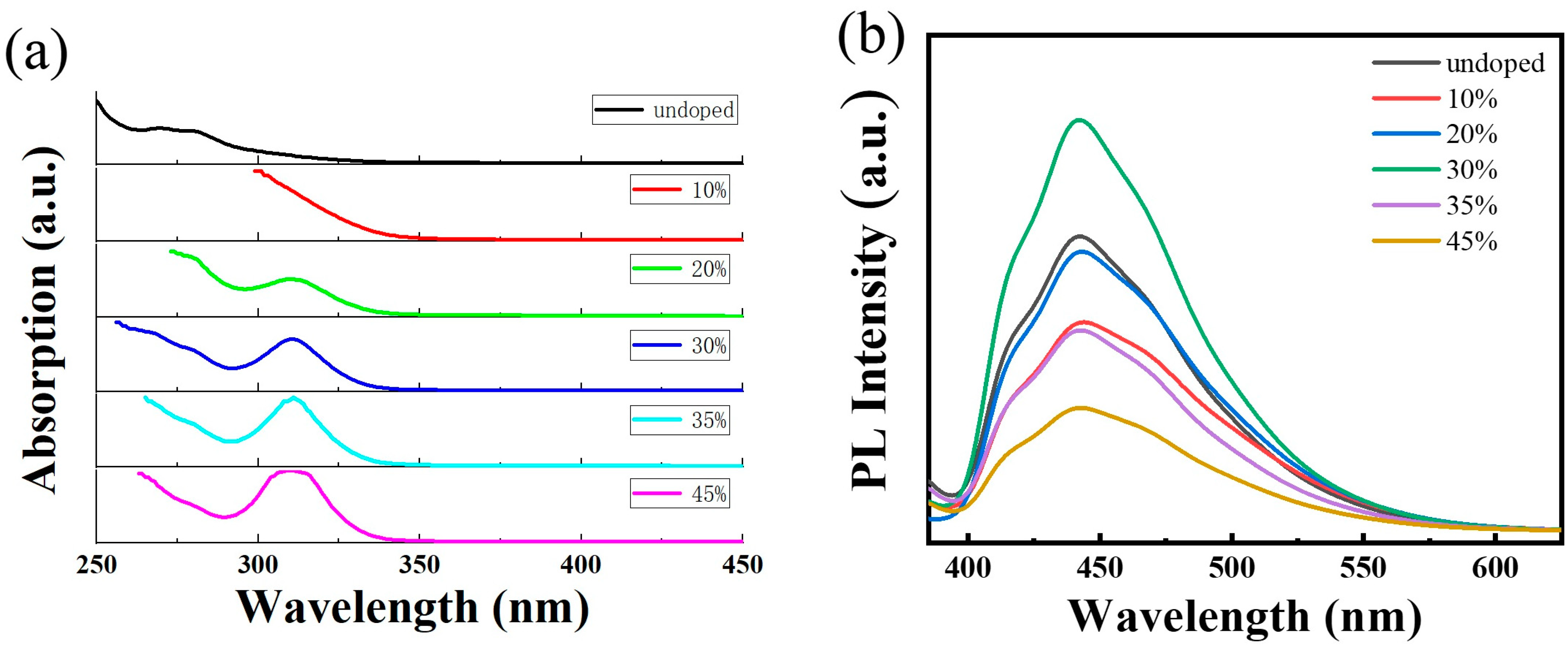

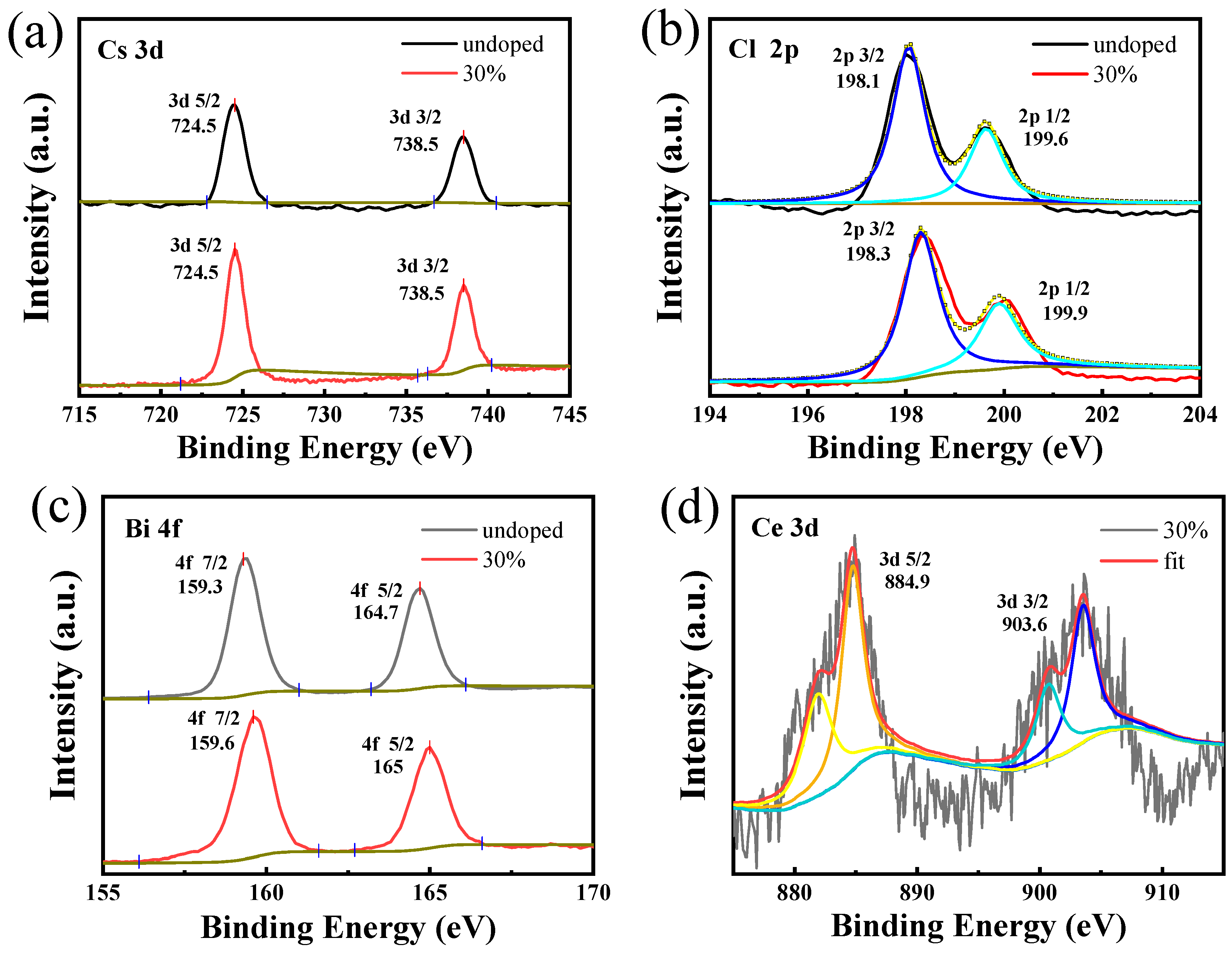
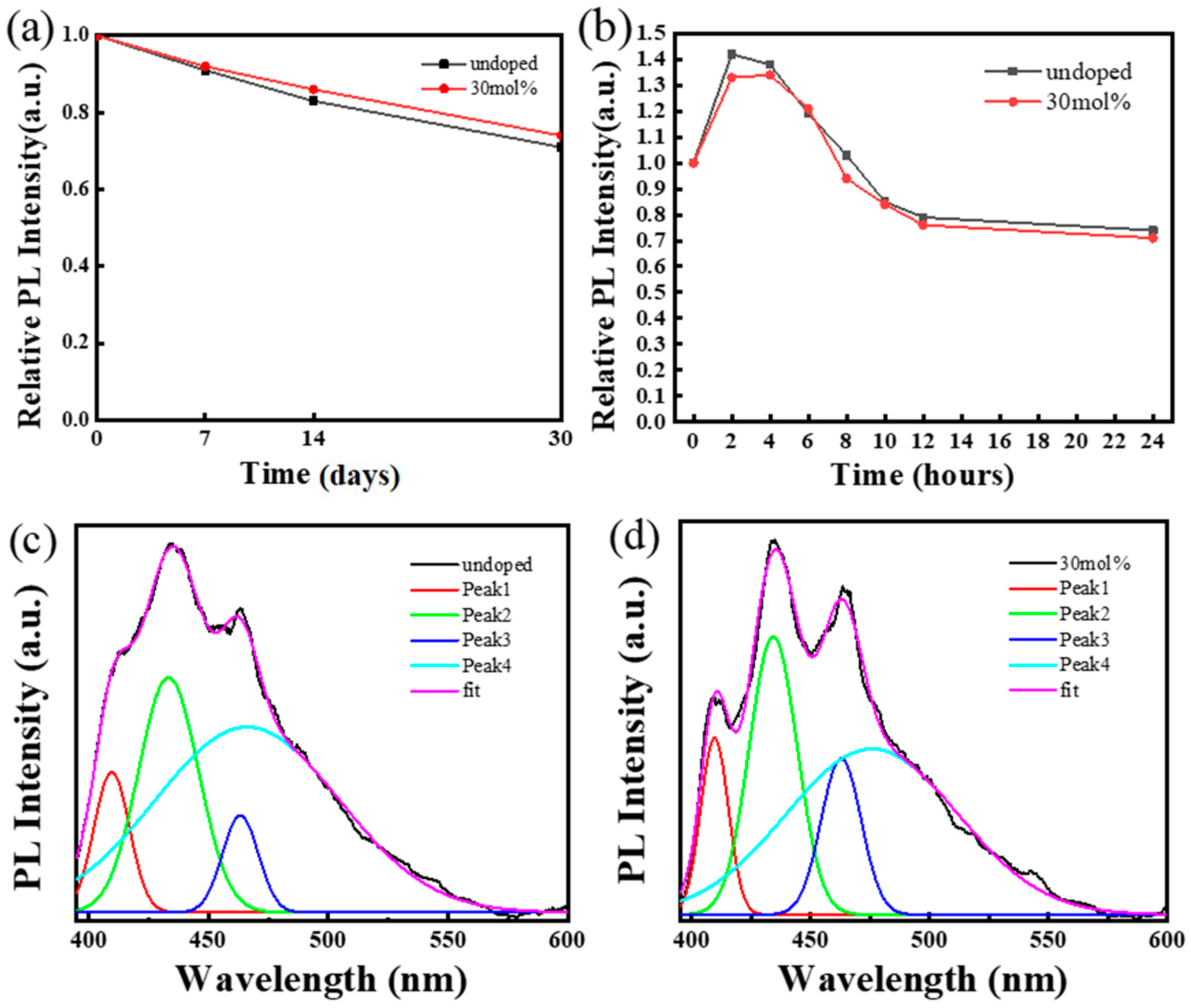
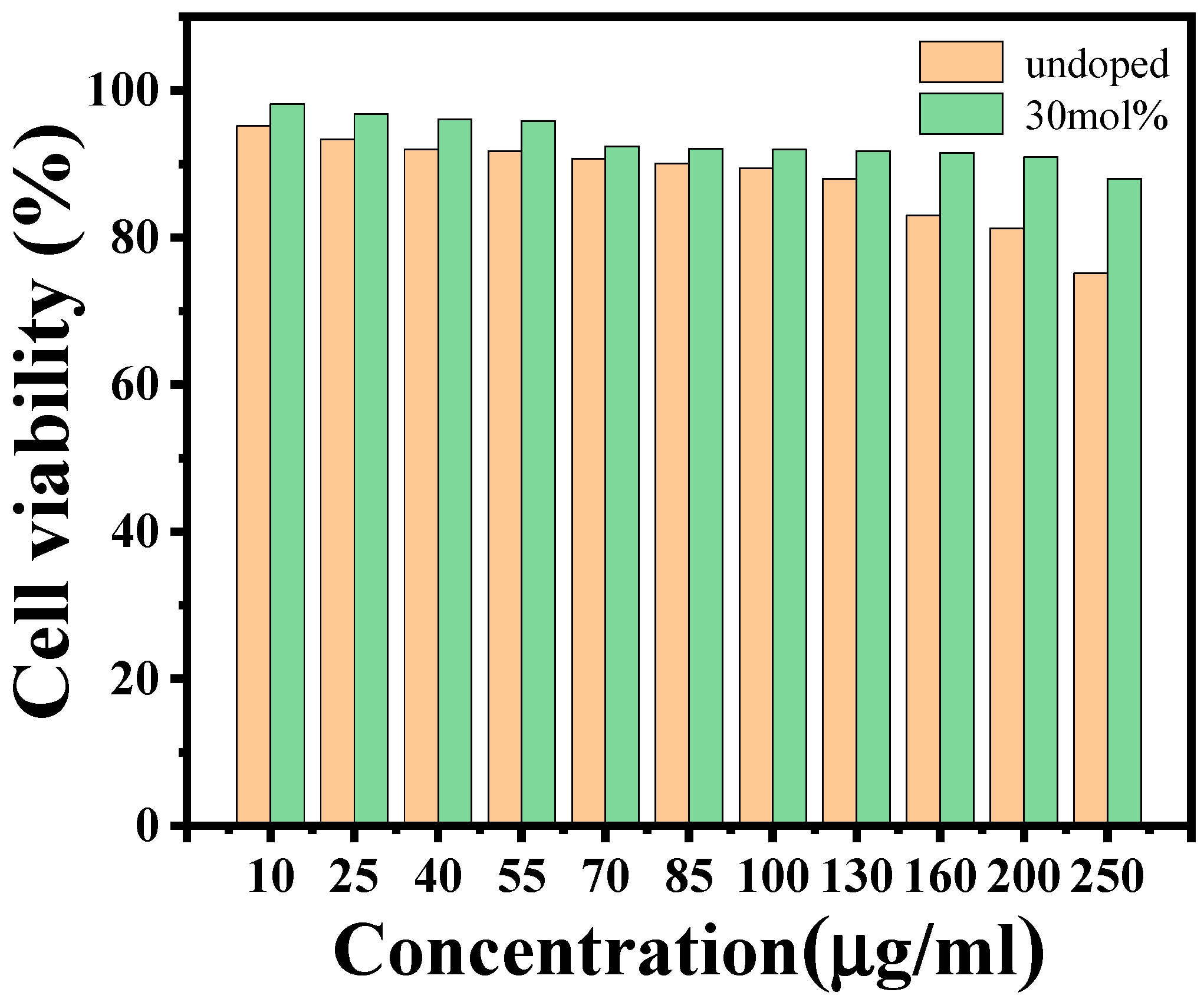
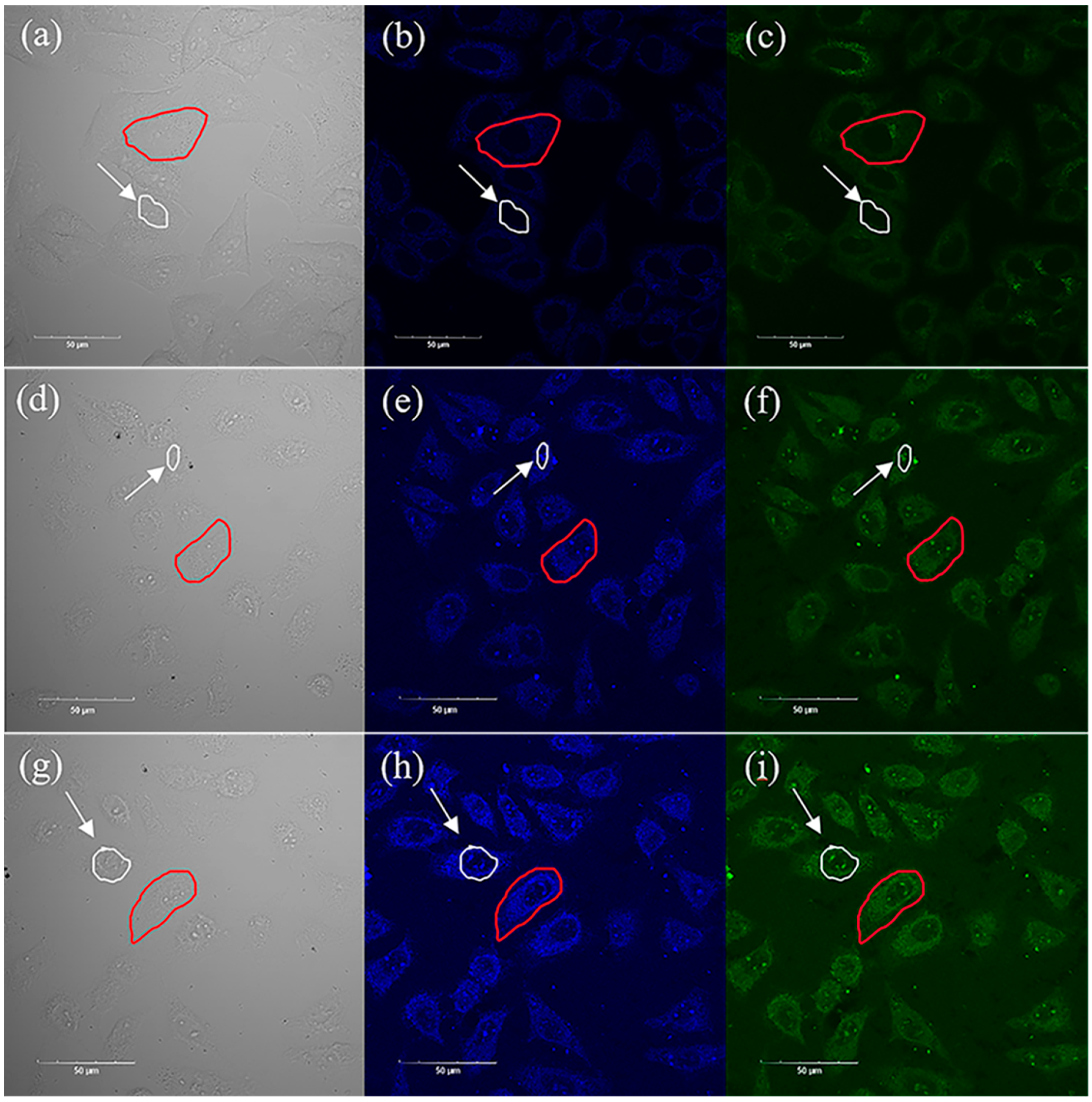
| QDs | PLQY (%) | Band Gap (eV) |
|---|---|---|
| undoped | 12.88 | 4.2 |
| 10 mol% | 10.32 | 4.0 |
| 20 mol% | 12.47 | 3.7 |
| 30 mol% | 22.12 | 3.8 |
| 35 mol% | 9.73 | 3.8 |
| 45 mol% | 5.78 | 3.7 |
| Undoped | 10 mol% | 20 mol% | 30 mol% | 45 mol% | |
|---|---|---|---|---|---|
| a Ce (wt %) | 2.78 | 5.94 | 9.32 | 14.18 | |
| b Bi (wt %) | 65.28 | 40.63 | 37.38 | 30.82 | 22.56 |
| c Ce/(Bi + Ce) mol% | 9.26 | 19.16 | 31.07 | 43.60 |
| Peak1 | Peak2 | Peak3 | Peak4 | |
|---|---|---|---|---|
| Position (nm) | 410 | 433 | 463 | 466 |
| Height | 38.7 | 64.1 | 27.1 | 50.8 |
| FHWM (nm) | 17.9 | 29.8 | 18.3 | 92.1 |
| Peak1 | Peak2 | Peak3 | Peak4 | |
|---|---|---|---|---|
| Position (nm) | 410 | 433 | 463 | 476 |
| Height | 47.9 | 74.6 | 42.4 | 45.0 |
| FHWM (nm) | 14.1 | 24.0 | 20.4 | 87.0 |
| QDs | Uptake (μg/Cell) |
|---|---|
| undoped | 4.42 × 10−5 |
| 30 mol% | 6.33 × 10−5 |
| Sample | (b) Control Blue | (c) Control Green | (e) Cs3Bi2Cl9 QDs Blue | (f) Cs3Bi2Cl9 QDs Green | (h) Cs3Bi2Cl9:Ce 30% QDs Blue | (i) Cs3Bi2Cl9:Ce 30% QDs Green |
|---|---|---|---|---|---|---|
| Intensity (min) | 9 | 9 | 10 | 11 | 10 | 12 |
| Intensity (max) | 44 | 48 | 104 | 76 | 141 | 81 |
| Intensity (mean) | 19.51 | 24.60 | 30.45 | 28.25 | 37.11 | 30.32 |
| Sample | (b) Control Blue | (c) Control Green | (e) Cs3Bi2Cl9 QDs Blue | (f) Cs3Bi2Cl9 QDs Green | (h) Cs3Bi2Cl9:Ce 30% QDs Blue | (i) Cs3Bi2Cl9:Ce 30% QDs Green |
|---|---|---|---|---|---|---|
| Intensity (min) | 10 | 10 | 13 | 11 | 14 | 13 |
| Intensity (max) | 28 | 32 | 92 | 69 | 127 | 87 |
| Intensity (mean) | 15.11 | 17.35 | 27.33 | 29.88 | 36.95 | 27.71 |
Disclaimer/Publisher’s Note: The statements, opinions and data contained in all publications are solely those of the individual author(s) and contributor(s) and not of MDPI and/or the editor(s). MDPI and/or the editor(s) disclaim responsibility for any injury to people or property resulting from any ideas, methods, instructions or products referred to in the content. |
© 2023 by the authors. Licensee MDPI, Basel, Switzerland. This article is an open access article distributed under the terms and conditions of the Creative Commons Attribution (CC BY) license (https://creativecommons.org/licenses/by/4.0/).
Share and Cite
Xiao, L.; Huang, L.; Su, W.; Wang, T.; Liu, H.; Wei, Z.; Fan, H. Efficiency Enhancement Strategies for Stable Bismuth-Based Perovskite and Its Bioimaging Applications. Int. J. Mol. Sci. 2023, 24, 4711. https://doi.org/10.3390/ijms24054711
Xiao L, Huang L, Su W, Wang T, Liu H, Wei Z, Fan H. Efficiency Enhancement Strategies for Stable Bismuth-Based Perovskite and Its Bioimaging Applications. International Journal of Molecular Sciences. 2023; 24(5):4711. https://doi.org/10.3390/ijms24054711
Chicago/Turabian StyleXiao, Liangyan, Linwei Huang, Weihaojia Su, Tianjun Wang, Haiying Liu, Zhongchao Wei, and Haihua Fan. 2023. "Efficiency Enhancement Strategies for Stable Bismuth-Based Perovskite and Its Bioimaging Applications" International Journal of Molecular Sciences 24, no. 5: 4711. https://doi.org/10.3390/ijms24054711
APA StyleXiao, L., Huang, L., Su, W., Wang, T., Liu, H., Wei, Z., & Fan, H. (2023). Efficiency Enhancement Strategies for Stable Bismuth-Based Perovskite and Its Bioimaging Applications. International Journal of Molecular Sciences, 24(5), 4711. https://doi.org/10.3390/ijms24054711







